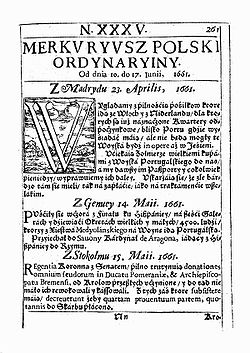
Merkuriusz Polski Ordynaryjny
Encyclopedia

Polish language
Polish is a language of the Lechitic subgroup of West Slavic languages, used throughout Poland and by Polish minorities in other countries...
spelling, Merkuryusz Polski Ordynaryiny; full title: Merkuriusz Polski dzieje wszystkiego świata w sobie zamykający, dla informacji pospolitej; "The Polish Mercury
Mercury (mythology)
Mercury was a messenger who wore winged sandals, and a god of trade, the son of Maia Maiestas and Jupiter in Roman mythology. His name is related to the Latin word merx , mercari , and merces...
Ordinary") was the first Polish
Poland
Poland , officially the Republic of Poland , is a country in Central Europe bordered by Germany to the west; the Czech Republic and Slovakia to the south; Ukraine, Belarus and Lithuania to the east; and the Baltic Sea and Kaliningrad Oblast, a Russian exclave, to the north...
newspaper
Newspaper
A newspaper is a scheduled publication containing news of current events, informative articles, diverse features and advertising. It usually is printed on relatively inexpensive, low-grade paper such as newsprint. By 2007, there were 6580 daily newspapers in the world selling 395 million copies a...
, published in 1661, first in Kraków
Kraków
Kraków also Krakow, or Cracow , is the second largest and one of the oldest cities in Poland. Situated on the Vistula River in the Lesser Poland region, the city dates back to the 7th century. Kraków has traditionally been one of the leading centres of Polish academic, cultural, and artistic life...
, then in Warsaw
Warsaw
Warsaw is the capital and largest city of Poland. It is located on the Vistula River, roughly from the Baltic Sea and from the Carpathian Mountains. Its population in 2010 was estimated at 1,716,855 residents with a greater metropolitan area of 2,631,902 residents, making Warsaw the 10th most...
.
Though short-lived, it gave name to several later newspapers, notably the Merkuriusz Polski published in London, 1955–58.
History
Merkuryusz Polski Ordynaryiny first came out in KrakówKraków
Kraków also Krakow, or Cracow , is the second largest and one of the oldest cities in Poland. Situated on the Vistula River in the Lesser Poland region, the city dates back to the 7th century. Kraków has traditionally been one of the leading centres of Polish academic, cultural, and artistic life...
on 3 January 1661. Sponsored by the court of King John Casimir of Poland and his consort Queen Ludwika Maria Gonzaga
Ludwika Maria Gonzaga
Marie Louise Gonzaga was queen consort to two Polish kings: Władysław IV Vasa, and John II Casimir Vasa...
, the newspaper was a weekly devoted chiefly to contemporary politics, European dynastic affairs, and monarchs' military campaigns. With regard to internal affairs, it promoted political reforms and the strengthening of monarchical power. Its demise was associated with the failure of the king's political plans.
Merkuryusz was edited in a 17th–century Polish heavily influenced by Latin
Latin
Latin is an Italic language originally spoken in Latium and Ancient Rome. It, along with most European languages, is a descendant of the ancient Proto-Indo-European language. Although it is considered a dead language, a number of scholars and members of the Christian clergy speak it fluently, and...
; some parts of issues were written purely in Latin. Initially published by the Kraków
Kraków
Kraków also Krakow, or Cracow , is the second largest and one of the oldest cities in Poland. Situated on the Vistula River in the Lesser Poland region, the city dates back to the 7th century. Kraków has traditionally been one of the leading centres of Polish academic, cultural, and artistic life...
printing house of J.A. Gorczyn (issues of 3 January – 4 May 1661), in May 1661 its editorial offices moved to Warsaw
Warsaw
Warsaw is the capital and largest city of Poland. It is located on the Vistula River, roughly from the Baltic Sea and from the Carpathian Mountains. Its population in 2010 was estimated at 1,716,855 residents with a greater metropolitan area of 2,631,902 residents, making Warsaw the 10th most...
, where the issues from 14 May through 22 July 1661 appeared. Altogether 41 issues came out (12 of them "extraordinary," or special), with a run of 100–250 copies. The last issue was dated 22 July 1661.
Merkuryusz was edited by Hieronim Pinocci, an Italian merchant who had migrated to Poland and served in notable posts in the royal administration, including those of master of the Kraków mint
Mint (coin)
A mint is an industrial facility which manufactures coins for currency.The history of mints correlates closely with the history of coins. One difference is that the history of the mint is usually closely tied to the political situation of an era...
and secretary to King Jan Kazimierz. Other collaborators included Łukasz Opaliński.
Between 1933 and 1939 the complete run was reprinted by the Polish National Library.

